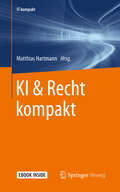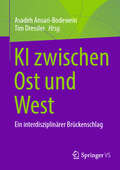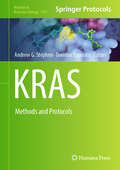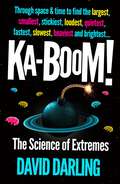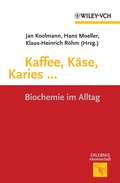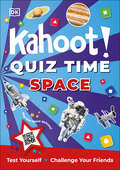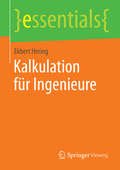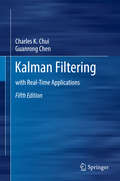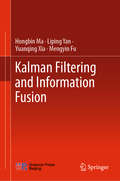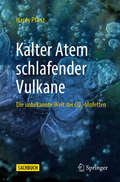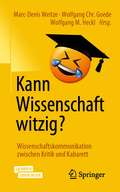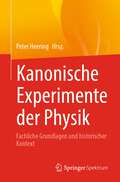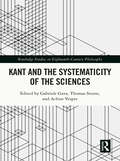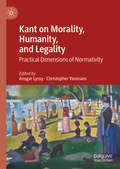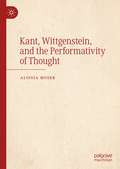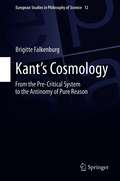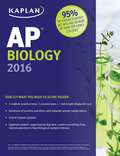- Table View
- List View
KI & Recht kompakt (IT kompakt)
by Matthias HartmannDas Buch gibt einen kompakten Einblick in alle wesentlichen Rechtsfragen rund um den Einsatz Künstlicher Intelligenz in Unternehmen oder Produkten. Versierte Autoren mit Praxiserfahrung erläutern die wichtigsten rechtlichen Themen beim Einsatz intelligenter Systeme und behandeln nach einer Einführung in die technischen Grundlagen die Auswirkungen und Besonderheiten Künstlicher Intelligenz in den Bereichen:ZivilrechtVertragsgestaltungLizenzierung HaftungImmaterialgüterrechte DatenschutzStrafrechtArbeitsrecht
KI zwischen Ost und West: Ein interdisziplinärer Brückenschlag
by Asadeh Ansari-Bodewein Tim DresslerDer vorliegende Band beleuchtet aktuelle Problemstellungen im Kontext der Entwicklung Künstlicher Intelligenz aus der Perspektive verschiedener akademischer Disziplinen (Philosophie, Sinologie, Informatik, Soziologie) und gibt einen Überblick über den jeweiligen Forschungsstand. Ein besonderes Augenmerk liegt dabei auf der Einbeziehung der sinologischen Perspektive, da China in Europa seit vielen Jahren insbesondere im Zusammenhang mit Diskussionen um die Auswirkungen von KI wahrgenommen wird.
KRAS: Methods and Protocols (Methods in Molecular Biology #2797)
by Andrew G. Stephen Dominic EspositoThis volume details protocols ranging from high yield production metabolically labeled KRAS for NMR studies to approaches that quantify engagement of novel molecules that bind KRAS in live cells. Chapters focus on protein production and characterization, biochemical assays, cell-based assays, KRAS-membrane interactions, targeting KRAS, and cell models. Written in the highly successful Methods in Molecular Biology series format, chapters include introductions to their respective topics, lists of the necessary materials and reagents, step-by-step, readily reproducible laboratory protocols, and key tips on troubleshooting and avoiding known pitfalls. Authoritative and cutting-edge, KRAS: Methods and Protocols aims to provide methods that will be instrumental in the development of future clinically approved KRAS therapeutics.
Ka-boom!: The Science of Extremes
by David DarlingWhat&’s the brightest light on Earth? The coldest corner of the universe? The blackest material ever made? The most poisonous substance in nature? &‘You will learn something new in every chapter, on every page and probably in every paragraph. Hugely entertaining.&’ Kit Yates, author of The Maths of Life and Death Ka-boom! probes extremes of size and speed, depth and density, and reveals the stickiest, sweetest, smelliest and nastiest substances known to science. In an unabashed celebration of the exceptional, David Darling takes an enlightening journey through the universe&’s weirdest and most wonderful extremes. Travel to far-flung galaxies in pursuit of habitable planets and extra-terrestrial life. Journey to the rainforests of South America and discover the top-speed of the notoriously sluggish sloth. Find out how Earth&’s hardiest creatures – tardigrades or &‘water bears&’ – ended up living on the moon. And meet the scientists and engineers using these quirks of nature to design faster computers, produce greener energy and revolutionise space travel.
Kabbalah
by Moshe Idel Shahar ArzyIn this book, the world’s foremost scholar of Kabbalah explores the understanding of erotic love in Jewish mystical thought. Encompassing Jewish mystical literatures from those of late antiquity to works of Polish Hasidism, Moshe Idel highlights the diversity of Kabbalistic views on eros and distinguishes between the major forms of eroticism. The author traces the main developments of a religious formula that reflects the union between a masculine divine attribute and a feminine divine attribute, and he asks why such an "erotic formula” was incorporated into the Jewish prayer book. Idel shows how Kabbalistic literature was influenced not only by rabbinic literature but also by Greek thought that helped introduce a wider understanding of eros. Addressing topics ranging from cosmic eros and androgyneity to the affinity between C. J. Jung and Kabbalah to feminist thought, Idel’s deeply learned study will be of consuming interest to scholars of religion, Judaism, and feminism.
Kaffee, Käse, Karies ...: Biochemie im Alltag (Erlebnis Wissenschaft)
by Jan Eds. KoolmanWhat is the kick we get from our morning cup of coffee or tea and why are we attracted by the smell of spices or perfume? How do the holes get in the cheese and why should you not clean your teeth after drinking a glass of wine? The authors have succeeded in explaining everyday objects in a scientific way to reveal hidden biochemical processes. This informative and richly illustrated book solves commonplace riddles in a readily comprehensible and entertaining manner, which you would probably not associate with biochemistry.
Kahoot! Quiz Time Space: Test Yourself Challenge Your Friends (Kahoot! Quiz Time)
by DKMore than 250 trivia questions for curious minds!What is the nearest neighbor to Earth? Do astronauts wear heated gloves? What is the force that pushes a rocket called? Find out in this quiz book, packed with questions and facts about space. Challenge yourself, your family, and friends with awesome questions based on the award-winning online Kahoot! games. Answer the questions, keep score, and declare the winner. Scan the QR codes throughout the book to find more cool quizzes on the same topics within Kahoot! and test your knowledge further. Go for gold and make learning awesome!
Kalahari
by Jessica KhouryDeep in the Kalahari Desert, a Corpus lab protects a dangerous secret...But what happens when that secret takes on a life of its own? When an educational safari goes wrong, five teens find themselves stranded in the Kalahari Desert without a guide. It's up to Sarah, the daughter of zoologists, to keep them alive and lead them to safety, calling on survival know-how from years of growing up in remote and exotic locales. Battling dehydration, starvation and the pangs of first love, she does her best to hold it together, even as their circumstances grow increasingly desperate. But soon a terrifying encounter makes Sarah question everything she's ever known about the natural world. A silver lion, as though made of mercury, makes a vicious, unprovoked attack on the group. After a narrow escape, they uncover the chilling truth behind the lion's silver sheen: a highly contagious and deadly virus that threatens to ravage the entire area--and eliminate life as they know it. In this breathtaking new novel by the acclaimed author of Origin and Vitro, Sarah and the others must not only outrun the virus, but its creators, who will stop at nothing to wipe every trace of it.
Kali's Song
by Jeanette WinterRenowned picture book author and illustrator Jeanette Winter brings us the enchanting story of a boy named Kali who lived thousands and thousands of years ago. Kali must learn to hunt, like the rest of the men in his tribe. But when Kali plucks the string on his bow, he forgets about shooting arrows, and makes music long into the night. Even the stars come close to listen. This lovely story, celebrating the uniqueness in all of us, the beauty of the natural world, and showing the power of music and art over violence, will be cherished by children everywhere.From the Hardcover edition.
Kalkulation für Ingenieure (essentials)
by Ekbert HeringDie Kalkulation errechnet Preise und Preisuntergrenzen für Produkte und Dienstleistungen. Sie liefert auch wertvolle Informationen für die Wirtschaftlichkeit, der Kostensenkung sowie der Erhöhung der Produktivität in allen Funktionen des Herstellungsprozesses. Behandelt werden die Methoden der Zuschlagskalkulation, die Berechnung der Maschinenstundensätze in der Fertigung sowie die Kalkulation mit Deckungsbeiträgen, mit Prozesskosten und die Kalkulation im Handel. Die klaren Strukturierungen ermöglichen dem Leser, seine Kalkulationsanforderungen in der Praxis sofort erfüllen zu können.
Kalman Filtering
by Guanrong Chen Charles K. ChuiKalman filtering algorithm gives optimal (linear, unbiased and minimum error-variance) estimates of the unknown state vectors of a linear dynamic-observation system, under the regular conditions such as perfect data information; complete noise statistics; exact linear modeling; ideal well-conditioned matrices in computation and strictly centralized filtering. In practice, however, one or more of the aforementioned conditions may not be satisfied, so that the standard Kalman filtering algorithm cannot be directly used, and hence OC approximate Kalman filteringOCO becomes necessary. In the last decade, a great deal of attention has been focused on modifying and/or extending the standard Kalman filtering technique to handle such irregular cases. It has been realized that approximate Kalman filtering is even more important and useful in applications. This book is a collection of several tutorial and survey articles summarizing recent contributions to the field, along the line of approximate Kalman filtering with emphasis on both its theoretical and practical aspects. "
Kalman Filtering and Information Fusion
by Yuanqing Xia Hongbin Ma Mengyin Fu Liping YanThis book addresses a key technology for digital information processing: Kalman filtering, which is generally considered to be one of the greatest discoveries of the 20th century. It introduces readers to issues concerning various uncertainties in a single plant, and to corresponding solutions based on adaptive estimation. Further, it discusses in detail the issues that arise when Kalman filtering technology is applied in multi-sensor systems and/or multi-agent systems, especially when various sensors are used in systems like intelligent robots, autonomous cars, smart homes, smart buildings, etc., requiring multi-sensor information fusion techniques. Furthermore, when multiple agents (subsystems) interact with one another, it produces coupling uncertainties, a challenging issue that is addressed here with the aid of novel decentralized adaptive filtering techniques.Overall, the book’s goal is to provide readers with a comprehensive investigation into the challenging problem of making Kalman filtering work well in the presence of various uncertainties and/or for multiple sensors/components. State-of-art techniques are introduced, together with a wealth of novel findings. As such, it can be a good reference book for researchers whose work involves filtering and applications; yet it can also serve as a postgraduate textbook for students in mathematics, engineering, automation, and related fields.To read this book, only a basic grasp of linear algebra and probability theory is needed, though experience with least squares, navigation, robotics, etc. would definitely be a plus.
Kalter Atem schlafender Vulkane: Die unbekannte Welt der CO2-Mofetten
by Hardy PfanzDieses auch für den interessierten Laien verständlich geschriebene Werk führt in die unbekannte Welt der CO2-Gasvulkane, der sogenannten Mofetten, ein. Eine wenig erforschte Welt, die inmitten von Europa Tiere sterben lässt, die Pflanzenwelt verändert, Böden und Atmosphäre beeinflusst und Hinweise für kommende Vulkanausbrüche liefern kann. Mithilfe der botanischen Bioindikation können solche Entgasungsstellen auch im Gelände gefunden und sogar wirtschaftlich genutzt werden, z.B. in Mineralwässern und Feuerlöschern, bei der Haltbarmachung von Nahrungsmitteln sowie bei der Heilung von Herz- und Hautkrankheiten. Prof. Hardy Pfanz erklärt in diesem biologisch-geologischen Mofettenführer, wo solche Erscheinungen in Deutschland, aber auch weltweit, gefunden werden können und was sie uns sagen. Auch verrät er –augenzwinkernd– das ein oder andere Außergewöhnliche und Sagenhafte über Mofetten.
Kamala's Art (Houghton Mifflin Vocabulary Reader Accompanies Journeys)
by Yuri Lubov Mary YoungNIMAC-sourced textbook <P><P>Level H DRA 14 Science Strategy
Kangaroos and Other Marsupials (World Book's Animals of the World)
by Julie A. FentonHave you always wondered what the difference between a Kangaroo, a Wallabee, and a Wallaroo is? Did you know that when Tasmanian Devils are angry their ears turn bright red? Did you know that Koalas smell like cough drops? Find out the answers to these and other fascinating facts in this informative book on marsupials, animals with pouches.
Kann Wissenschaft witzig?: Wissenschaftskommunikation zwischen Kritik und Kabarett
by Marc-Denis Weitze Wolfgang M. Heckl Wolfgang Chr. Goede"Kann Wissenschaft witzig?“ nimmt ein ebenso innovatives wie zukunftsträchtiges Element moderner Wissenschaftskommunikation unter die Lupe: Die Komik!Leserinnen und Leser werden durch anschaulich gehaltene akademische Theorie sowie spannende Hands-on- und Best Practice-Beispiele renommierter Praktiker und Kabarettisten geführt:· Was haben Schafskäse und Autoreifen gemeinsam?· Kann Lachen Mauern einreißen lassen?· Wie funktioniert „Die Anstalt“· Wie schafft Zauberkunst Wissen?· Gibt es Humor im Museum?· Kommt ein Dalmatiner an die Kasse· Drei Schritte zum Humor· Serviervorschlag für den Heiligen Geist· Diktatur der Dummheit· Und viel mehr!Das ist aber nicht alles nur lustig. Komik kann auch Kritik etwas von ihrer beißenden Schärfe nehmen, die Kritik für die Adressaten verdaulich, ja sogar schmackhaft machen.„Kann Wissenschaft witzig?“ navigiert zwischen Kritik und Kabarett und setzt sich mit Komik in verschiedenen Spielarten aus unterschiedlichen Perspektiven auseinander. 22 Beiträge zeigen, wie sich die Ergebnisse von Wissenschaft, Forschung, Technologie auf neuen Wegen in die breite Öffentlichkeit tragen lassen. Sie demonstrieren insbesondere auch, wie Humor sich als kritisch-fragende Kraft einsetzen lässt – wertvoll für sämtliche Kommunikationsarten und hilfreich, damit sie in Zukunft gewitzter daherkommen.
Kanonische Experimente der Physik: Fachliche Grundlagen und historischer Kontext
by Peter HeeringDieses Buch ermöglicht in 14 Fallstudien ein tieferes Verständnis von kanonischen Experimenten der Physik und bietet Hintergründe zu deren Aufbauten und Durchführung sowie dem jeweiligen historischen Kontext. Es diskutiert, wie genau diese Experimente ausgeführt wurden und welche physikalischen Gründe es für die Auswahl der verwendeten Instrumente gab. Ebenso wird dargestellt, warum die jeweiligen Forscher diese Experimente durchführten und wie diese Ergebnisse akzeptiert werden konnten.Während eine Reihe von diesen Experimenten und deren Methoden, wie das Geiger-Müller-Zählrohr oder das Youngsche Doppelspaltexperiment, Physiklehrkräften sowie (angehenden) Physikerinnen und Physikern zwar vom Funktionsprinzip her bekannt sind, liefert dieses Buch die Hintergründe um die Herausforderungen zu verstehen, die sich beim Experimentieren stellen und die auch den Reiz des experimentellen Arbeitens ausmachen können. Es verdeutlicht, warum Forschende forschen, worin die Motivation besteht und wie veränderlich naturwissenschaftliche Praktiken in der Zeit sind. Damit leisten die hier zusammengeführten Fallstudien einen Beitrag, Physik nicht als einen Wissenskanon, sondern als einen kulturell geprägten von Menschen getragenen Prozess zu verstehen. Das Buch eignet sich damit besonders für Studierende (sowohl fachwissenschaftlich als auch des Lehramts) sowie Lehrende an Universitäten und (Hoch-)Schulen.Der InhaltDas Hookesche Gesetz – Newtons prismatische Farbzerlegung – Das Coulombsche Gesetz – Youngs Doppelspaltexperiment – Das Ohmsche Gesetz – Die Messung der Lichtgeschwindigkeit durch Fizeau bzw. Foucault – Joules Bestimmung des mechanischen Wärmeäquivalents – Spektralanalyse nach Bunsen und Kirchhoff – Die Wilsonsche Nebelkammer – Das Franck-Hertz-Experiment – Millikans Bestimmung der Elementarladung – Das Geiger-Müller-Zählrohr – Kosmische Hintergrundstrahlung
Kant and the Laws of Nature
by Michela Massimi Angela BreitenbachLaws of nature play a central role in Kant's theoretical philosophy and are crucial to understanding his philosophy of science in particular. In this volume of new essays, the first systematic investigation of its kind, a distinguished team of scholars explores Kant's views on the laws of nature in the physical and life sciences. Their essays focus particularly on the laws of physics and biology, and consider topics including the separation in Kant's treatment of the physical and life sciences, the relation between universal and empirical laws of nature, and the role of reason and the understanding in imposing order and lawful unity upon nature. The volume will be of great interest to advanced students and scholars of Kant's philosophy of science, and to historians and philosophers of science more generally.
Kant and the Systematicity of the Sciences (Routledge Studies in Eighteenth-Century Philosophy)
by Thomas Sturm Gabriele Gava Achim VesperThis book provides the first comprehensive discussion regarding the role that Kant ascribes to systematicity in the sciences. It considers not only what Kant has to say on systematicity in general, but also how the systematicity requirement for science is specified in different fields of knowledge.The chapters are divided into three thematic sections. Part I is devoted to historical context. The chapters explore precursors of Kant’s account of the systematicity of the sciences. Part II addresses the application of systematicity to the special sciences – cosmology, physics, chemistry, logic, mathematics, the life sciences, and history. Finally, Part III explores the systematicity of philosophy.Kant and the Systematicity of the Sciences will be of interest to scholars and advanced students working on Kant and the history and philosophy of science.
Kant on Morality, Humanity, and Legality: Practical Dimensions of Normativity
by Ansgar Lyssy Christopher YeomansIt was not so long ago that the dominant picture of Kant’s practical philosophy was formalistic, focusing almost exclusively on his Groundwork of the Metaphysics of Morals and Critique of Practical Reason. However, the overall picture of Kant’s wide-ranging philosophy has since been broadened and deepened. We now have a much more complete understanding of the range of Kant’s practical interests and of his contributions to areas as diverse as anthropology, pedagogy, and legal theory. What remains somewhat obscure, however, is how these different contributions hang together in the way that Kant suggests that they must. This book explores these different conceptions of humanity, morality, and legality in Kant as main ‘manifestations’ or ‘dimensions’ of practical normativity. These interrelated terms play a crucial role in highlighting different rational obligations, their source(s), and their applicability in the face of changing circumstances.
Kant on Proper Science
by Hein van den BergThis book provides a novel treatment of Immanuel Kant's views on proper natural science and biology. The status of biology in Kant's system of science is often taken to be problematic. By analyzing Kant's philosophy of biology in relation to his conception of proper science, the present book determines Kant's views on the scientific status of biology. Combining a broad ideengeschichtlich approach with a detailed historical reconstruction of philosophical and scientific texts, the book establishes important interconnections between Kant's philosophy of science, his views on biology, and his reception of late 18th century biological theories. It discusses Kant's views on science and biology as articulated in his published writings and in the Opus postumum. The book shows that although biology is a non-mathematical science and the relation between biology and other natural sciences is not specified, Kant did allow for the possibility of providing scientific explanations in biology and assigned biology a specific domain of investigation.
Kant's Construction of Nature
by Michael FriedmanKant's Metaphysical Foundations of Natural Science is one of the most difficult but also most important of Kant's works. Published in 1786 between the first (1781) and second (1787) editions of the Critique of Pure Reason, the Metaphysical Foundations occupies a central place in the development of Kant's philosophy, but has so far attracted relatively little attention compared with other works of Kant's critical period. Michael Friedman's book develops a new and complete reading of this work and reconstructs Kant's main argument clearly and in great detail, explaining its relationship to both Newton's Principia and eighteenth-century scientific thinkers such as Euler and Lambert. By situating Kant's text relative to his pre-critical writings on metaphysics and natural philosophy and, in particular, to the changes Kant made in the second edition of the Critique, Friedman articulates a radically new perspective on the meaning and development of the critical philosophy as a whole.
Kant, Wittgenstein, and the Performativity of Thought
by Aloisia MoserThis book explores the idea that there is a certain performativity of thought connecting Kant’s Critique of Pure Reason and Wittgenstein’s Tractatus Logico-Philosophicus. On this view, we make judgments and use propositions because we presuppose that our thinking is about something, and that our propositions have sense. Kant’s requirement of an a priori connection between intuitions and concepts is akin to Wittgenstein’s idea of the general propositional form as sharing a form with the world. Aloisia Moser argues that Kant speaks about acts of the mind, not about static categories. Furthermore, she elucidates the Tractatus’ logical form as a projection method that turns into a so-called ‘zero method’, whereby propositions are merely the scaffolding of the world. In so doing, Moser connects Kantian reflective judgment to Wittgensteinian rule-following. She thereby presents an account of performativity centering neither on theories nor methods, but on the application enacting them in the first place.
Kant’s Cosmology: From the Pre-Critical System to the Antinomy of Pure Reason (European Studies in Philosophy of Science #12)
by Brigitte FalkenburgThis book provides a comprehensive account of Kant’s development from the 1755/56 metaphysics to the cosmological antinomy of 1781. With the Theory of the Heavens (1755) and the Physical Monadology (1756), the young Kant had presented an ambitious approach to physical cosmology based on an atomistic theory of matter, which contributed to the foundations of an all-encompassing system of metaphysics. Why did he abandon this system in favor of his critical view that cosmology runs into an antinomy, according to the Critique of Pure Reason (CPR)? This book answers this question by focusing on Kant’s methodology and the internal problems of his 1755/56 theory of nature. A decisive role for Kant’s critical turn plays the argument from incongruent counterparts (1768), which drew much attention among philosophers of science, though not sufficiently in Kant research. Furthermore, the book analyses the genesis of the cosmological antinomy in the 1770s, the logical structure of the antinomy in the CPR, its relation to transcendental idealism, as explained in the “experiment of pure reason” (1787), and its role for the teleology of human reason. The book is addressed to Kant scholars, philosophers of science, and students of Kant’s philosophy.
Kaplan AP Biology 2016
by Linda Brooke Stabler Mark Metz Allison WilkesThe Advanced Placement exam preparation guide that delivers 75 years of proven Kaplan experience and features exclusive strategies, practice, and review to help students ace the NEW AP Biology exam!Students spend the school year preparing for the AP Biology exam. Now it's time to reap the rewards: money-saving college credit, advanced placement, or an admissions edge. However, achieving a top score on the AP Biology exam requires more than knowing the material--students need to get comfortable with the test format itself, prepare for pitfalls, and arm themselves with foolproof strategies. That's where the Kaplan plan has the clear advantage.Kaplan's AP Biology 2016 has been updated for the NEW exam and contains many essential and unique features to improve test scores, including:2 full-length practice tests and a full-length diagnostic test to identify target areas for score improvementDetailed answer explanationsTips and strategies for scoring higher from expert AP teachers and students who scored a perfect 5 on the examEnd-of-chapter quizzesTargeted review of the most up-to-date content and key information organized by Big Idea that is specific to the revised AP Biology exam Kaplan's AP Biology 2016 provides students with everything they need to improve their scores--guaranteed. Kaplan's Higher Score guarantee provides security that no other test preparation guide on the market can match. Kaplan has helped more than three million students to prepare for standardized tests. We invest more than $4.5 million annually in research and support for our products. We know that our test-taking techniques and strategies work and our materials are completely up-to-date for the NEW AP Biology exam. Kaplan's AP Biology 2016 is the must-have preparation tool for every student looking to do better on the NEW AP Biology test!
